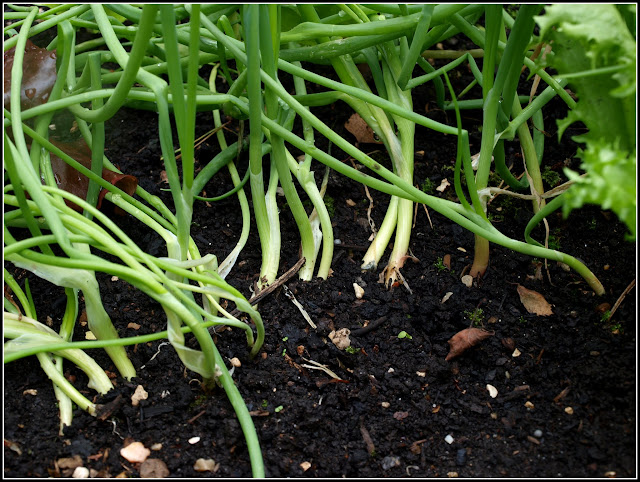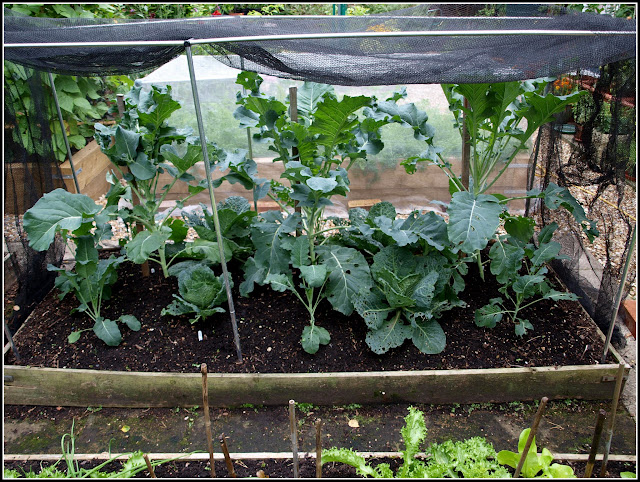These Spring Onions were sown on May 17th.
I'm doing a lot of waiting for crops just now. These tomatoes are just beginning to turn colour, and I am tempted to pick them (especially since I have seen some blight on a couple of the plants), but I know that it makes sense to leave them on the plant a bit longer to allow the flavour to develop.
Purple Sprouting Broccoli is definitely not a crop for the impatient. It takes about 10 months from sowing to harvesting. Mine is usually sown in April / May and picked in February / March (with some variation according to variety). To maximise the use of space while I am waiting for the PSB to grow, I under-plant it with other crops, like the Cabbages and Brokali seen here.
This is Brokali "Apollo". It is a cross between Kale and Chinese Broccoli. The Kale parentage is very apparent in my next photo. Actually it looks as if Cavolo Nero (Lacinato Kale) was the parent of this one.
I am hoping that the Brokali will mature fairly soon, before its light is completely blocked out by the PSB. likewise, the Cabbages will be cut in early Winter, whereas the PSB will not be ready until the Spring.
Of course the patience-requiring vegetable par excellence is Asparagus.
You generally have to wait three years before getting a crop (possibly reduced to two if you plant reasonable-sized crowns). At present I have a dilemma concerning Asparagus. Next year I need to build more raised beds (yes, need, not want - the wood of the existing ones is rotting away), so what am I to do with my mature Asparagus plants? One way or another they have to come up, so should I try to transplant and re-establish them or should I get some new ones (and therefore wait 2 or 3 years for a harvest)? This is an Asparagus plant I grew from seed this year - still very tiny.
I am seriously considering whether I should be growing Asparagus at all. When I first planted it, Asparagus was still considered a relative luxury and was quite expensive to buy. Now it is in the shops all year round (albeit imported from Peru) and its price has come down a lot. Does it therefore have the right level of Value for Space Rating any more? Being a perennial, Asparagus permanently ties up one of my raised beds and only delivers its crop for a few weeks each year. Maybe it would be better to grow some other things instead? I'm currently undecided.







That sounds like a hard decision. Asparagus is such a nice vegetable. I can't seem to grow it here. It always dies off within a year or two. I'm not sure what disease is in the soil, but I've tried in multiple places. But asparagus doesn't produce a lot of poundage for the space. However for a small home garden I'd ignore the monetary value of the crop, but go for what crop you can grow that tastes better homegrown than store bought. I've never had homegrown asparagus, so haven't a clue if it is a lot better than what you get at the store.
ReplyDeleteAre you really thinking of getting rid of your asparagus, I remember thinking the same thing before I extended my asparagus bed. Yes you can buy it cheaply all year round but the taste really isn't the same or the texture. We occasionally buy it from our local farm shop where it commands a high price, I wish you luck with your decision making I know it wont be an easy one.
ReplyDeleteMono-culture is a bit of a luxury where space is limited, so I would be tempted to harvest asparagus from a pick-your-own farm or farm shop (ie fresh & local) and use the bed for a variety of other tasty crops to help fill those seasonal gaps.
ReplyDeleteWhatever has happened to spring onions? They used to be so easy to grow. Now we just can't seem to get a decent cropping. We never got round to sowing Brokali so it will be interesting to see what you make of it
ReplyDeleteIt will be sad if you have to give up on your asparagus. I considered asparagus as an add-on crop & only started some this year, once I had enough beds for what I consider more essential crops. Having said that, I've never tasted homegrown asparagus so can't really comment on its taste vs. store bought. Once I do taste it, I may regret not having used one of my other beds to start it sooner.
ReplyDeleteYou make an interesting point about the asparagus. The price in groceries does seem to be much better these days. I haven't grown asparagus but seems like quite a bit of space used for limited outputs. Suppose depends on how much you enjoy growing your own, or if you have something else that you'd rather be growing and need the space.
ReplyDeleteSo, if you decide to keep the asparagus, why not just build the new raised bed around the old one, then remove the rotting boards? Seems like a simple solution with minimal impact. I enjoy your blog and have learned a good bit about veggies (although perhaps more than I ever wanted to know about broccoli, heh heh)!
ReplyDeleteYour plan won't work for me, I'm afraid, because (due to the greater width of my new design) the bed needs to be shifted sideways about 40cm. Sorry about the PSB overdose, but you know how much I love that veg!
Delete